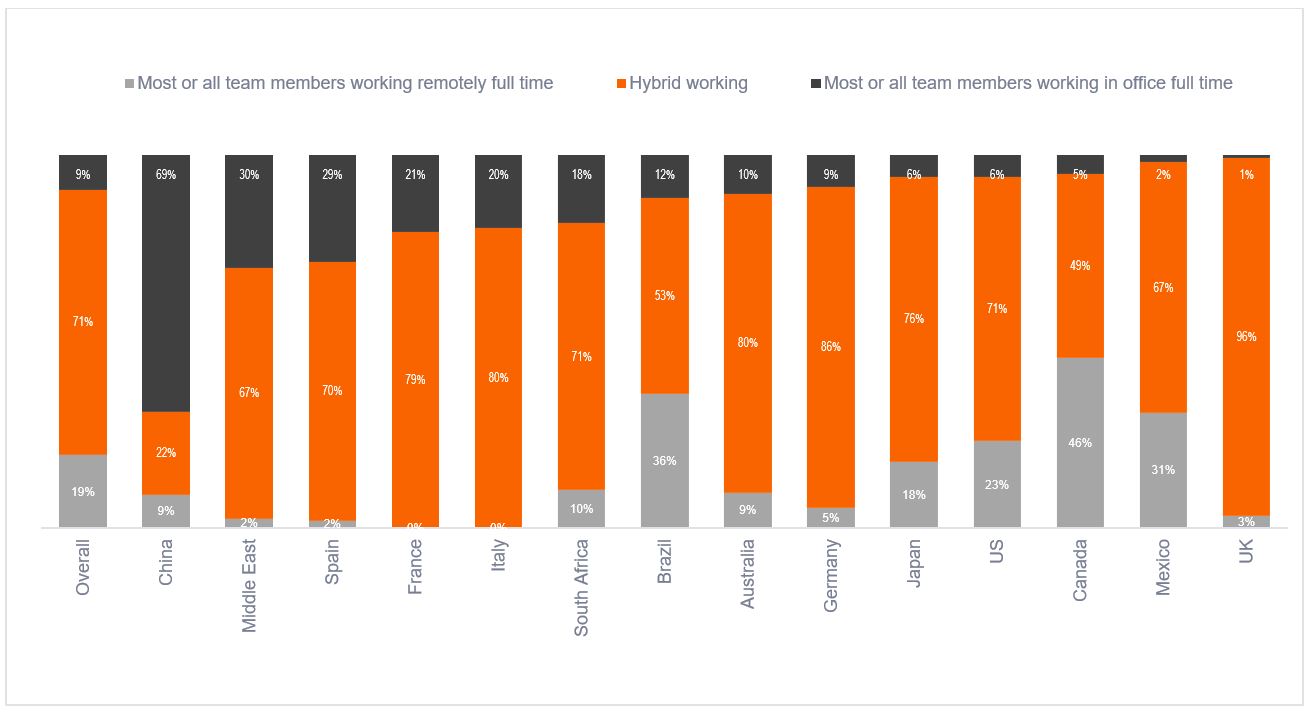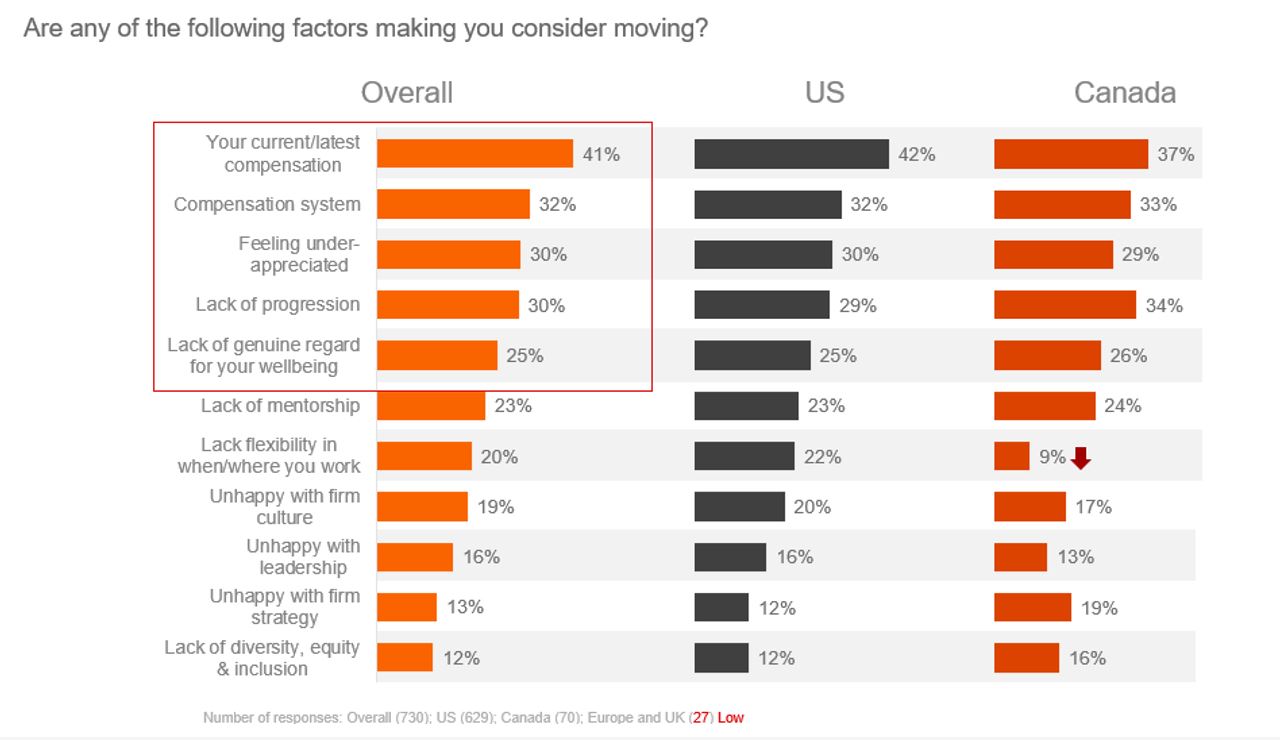Law firm talent strategies are being impacted by two key factors: how well firms’ return-to-office planning is going, and how deep the firms’ concerns are over associate retention
These factors were critical topics at a recent gathering of more than 20 chief talent officers (CTOs) from law firms in the United States and the United Kingdom that was held in early May, and sponsored by Thomson Reuters. Further, Thomson Reuters Market Insights data underscores the complexity and tenuous realities of both of these topics:
-
-
- Interviews with more than 30 managing partners of global law firms indicated return-to-office planning is still being debated within many firms.
- Indeed, 40% of lawyers indicated that they have complete flexibility concerning the days on which they report to the office, and 50% said they are working in a hybrid environment, according to Market Insights Standout Talent research, which noted these results vary across geographies.
-

Associate retention is still a delicate balance
On the question of associate retention, 46% of associates are currently seen to be flight risks, according to separate data from the Thomson Reuters Institute. And the three main drivers influencing whether lawyers will leave their current firms (beyond compensation) are i) management’s lack of regard for lawyers’ genuine well-being; ii) feeling under-appreciated or not seen; and iii) a lack of career progression.

Building a culture of well-being
At the recent event, small group discussions with CTOs revealed the strong need for firms and firm leaders to build a culture of well-being for their lawyers, especially those in hybrid work situations. This culture of well-being should be based on the following three pillars:
1. Defining clarity around how the lawyer’s role fits with the firm’s goals and what lawyers need to achieve to ensure their own progression;
2. Offering lawyers control over what, when, and how they work; and
3. Supporting people’s well-being, including offering training programs, and meditation and fitness apps.
Most firms have centered their well-being programs on support, even though efforts to increase clarity and control are shown to have the most impact on building a culture of well-being. Below are several of the best practices highlighted by the participating CTOs to help build this culture of well-being:
Clarifying performance expectations to increase control. Rearticulating to associates the expectations of their roles brought great clarity. In turn, increased clarity through setting expectations enabled increased control, and therefore, their wellbeing among associates.
Develop a ‘stronger voices’ campaign — One CTO said her firm is tackling this objective through the creation of a “Stronger Voices” campaign to highlight how people have dealt with mental health challenges. This helps with attorneys who may not be feeling psychologically safe nor able to bring themselves to work authentically.
Link improved well-being and connectivity through the benefits of the return-to-office plan — One law firm is enhancing its relationship-building and offering better support networks as a way to cultivate in-person connections at the office, according to another CTO.
Ways to expand appreciation
The culture of an organization is reflected in employees’ perception of the collected experiences they have in group settings and individual work. Consistency in behaviors that are aligned with the firm’s cultural values is necessary to align those values — often written on the firm’s website — with employees’ individualized experiences. Appreciation is a key mechanism to drive this consistency.
Little wonder then that the CTOs we spoke to advised law firm leaders to engage in the following actions:
Make appreciation personal — Encouraging partners and team leaders to take the time to acknowledge and appreciate team members on an ongoing basis is more impactful than many firmwide initiatives. One CTO said her firm emphasized that it “appreciates people as ‘individuals’ rather than a ‘group of associates’” even though it is “hard to do at the firm-programming level because that is dependent upon individual practice and matter teams.”
Demonstrate appreciation through career development options or ‘appreciation’ programs — One of the best ways law firms can demonstrate appreciation is by employing a consistent commitment that underscores how the law firm cares about each associate’s career progression. Many law firms are working hard to offer different career paths in addition to the path to partnership.
Another CTO says his firm uses “appreciation points” to identify a job well done and as a way to say thank you. Research also shows how valuable these programs work, even surpassing compensation bumps as a key retention tactic.
Ways to improve career progression
While many CTOs acknowledged the difficulty in offering career paths outside of the path to partnership, some innovative CTOs are experimenting. Here are some actions that are driving their success:
-
-
- Provide clarity of expectations and individual development — One CTO said his firm is employing a career lattice, which potential career moves happen laterally, downward, or upward rather than just a simple upward career trajectory.
- Highlight associates’ ability to develop transferable skills — Some law firms have begun stressing how associates can develop transferable skills, and even acknowledging that associates are likely to move employers during their careers. Interestingly, this has generated loyalty towards the firm rather than encouraging associates to leave it.
- Align partner compensation incentives to how well they train and coach — One law firm accomplished this through an upward evaluation process where partners are assessed on how well they “demonstrate interest in [associates’] career progression” and “strong mentoring,” says another CTO.
-
Challenges remain
Many law firms still have a way to go to address the talent challenges faced by their CTOs in today’s legal environment. Many CTOs were consistent in identifying two key challenges in return-to-office planning and associate career progression:
-
-
- Building a culture of feedback — One of the biggest challenges for law firms’ CTOs is gaining the buy-in from partners to deliver real-time feedback to improve associate retention. Feedback is essential for associates to know in which areas and how they need to improve.
- Avoiding romanticizing the past — Another challenge, especially in the current hybrid work model, is the propensity of those in leadership to look at the traditional means of working in-person, in an office as some golden era to which the firm needs to revert. “It’s quite shocking how much time we’re spending lamenting that,” said one CTO. “It’s a little wasteful.” Another CTO indicated that “this allure of lawyers learning by osmosis and working shoulder-to-shoulder is a real obstacle to moving forward. It wasn’t real, and associates didn’t see it that way.”
-
Another CTO offered a more positive perspective. “I have been harassing people about mentoring projects and maximizing mentoring projects for 15 years,” the CTO says, adding that it’s good that others are recognizing the value in this now too. “We now have an opportunity because people are focused on it.”







